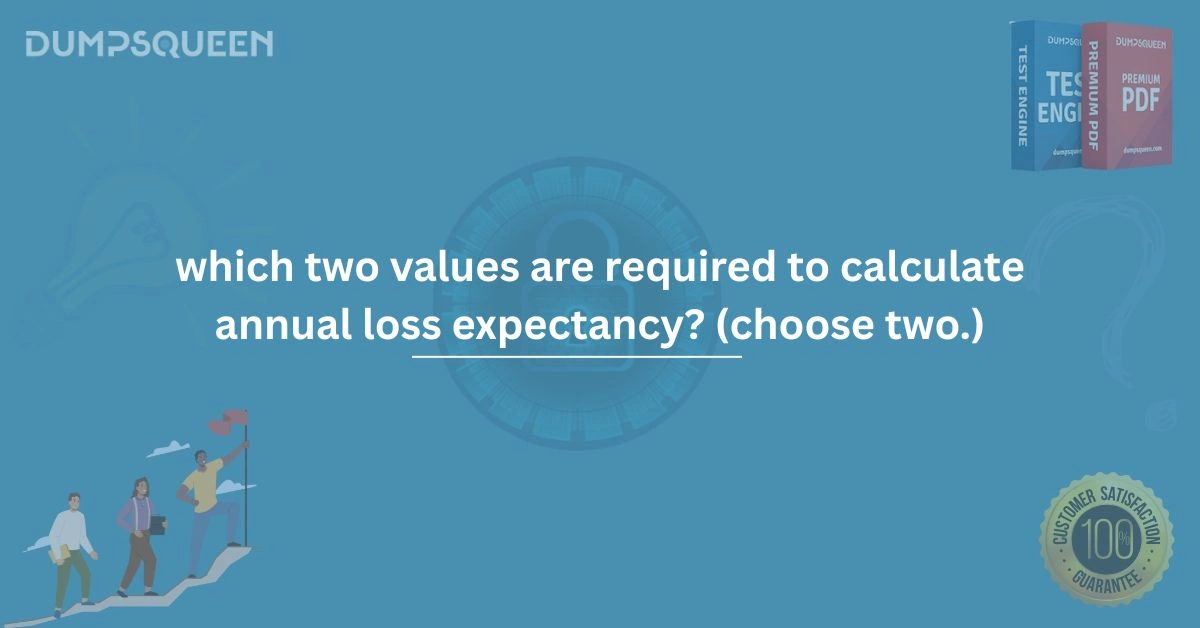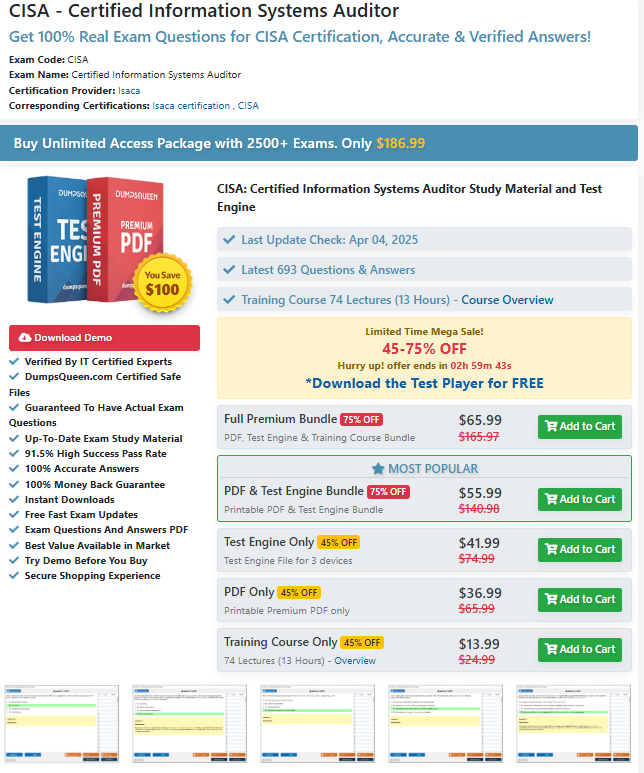Introduction
In the ever-evolving realm of cybersecurity and risk management, understanding how to evaluate threats and quantify potential losses is a fundamental skill. One essential metric that every security professional must master is the Annual Loss Expectancy (ALE). ALE plays a crucial role in helping organizations determine the financial impact of security threats over a year. The concept of ALE is a cornerstone in many information security certification exams such as CompTIA Security+, CISSP, and CISM. If you're studying for these exams and using reliable resources like DumpsQueen, then understanding how ALE is calculated and specifically, which two values are required to calculate Annual Loss Expectancy will be pivotal to your success. This blog will explore ALE in detail, identify the two critical values used in its calculation, discuss real-world examples, and provide sample questions with answers to help reinforce your learning.
Understanding Annual Loss Expectancy (ALE)
Annual Loss Expectancy is a quantitative risk analysis technique used to estimate the yearly financial impact of a potential threat. It allows organizations to assess the effectiveness of their security controls by evaluating how much a particular threat could cost them annually. The formula for calculating ALE is simple, yet powerful: ALE = SLE × ARO Where:
-
SLE stands for Single Loss Expectancy
-
ARO stands for Annual Rate of Occurrence
Thus, the two values required to calculate Annual Loss Expectancy are:
-
Single Loss Expectancy (SLE)
-
Annual Rate of Occurrence (ARO)
This is the correct answer to the question: “Which two values are required to calculate annual loss expectancy? (Choose two.)”
Single Loss Expectancy (SLE)
Single Loss Expectancy refers to the monetary loss an organization would incur if a specific risk event were to occur just once. It is a way of measuring the financial impact of a single instance of a threat. SLE is calculated as: SLE = Asset Value × Exposure Factor
-
Asset Value (AV): This represents the total worth of the asset at risk.
-
Exposure Factor (EF): This indicates the percentage of the asset that would be lost due to a specific threat.
For example, if a server is valued at $100,000 and a cyberattack would cause a 25% loss, the SLE would be: SLE = $100,000 × 0.25 = $25,000 This means that a single incident would cost the organization $25,000. Understanding SLE is vital for anyone preparing for security certifications. DumpsQueen offers extensive study materials that dive deep into such calculations, making your exam preparation efficient and targeted.
Annual Rate of Occurrence (ARO)
The Annual Rate of Occurrence is an estimate of how often a particular threat is expected to occur in one year. It is usually based on historical data, expert judgment, or industry analysis. ARO is expressed as a numeric value:
-
If a threat is expected to occur once every five years, the ARO is 0.2.
-
If it’s likely to happen twice a year, the ARO is 2. Using our previous example:
-
If a data breach with an SLE of $25,000 is expected to occur once every two years (ARO = 0.5), then: ALE = $25,000 × 0.5 = $12,500 This means the organization should expect to lose $12,500 annually from this threat.
The Importance of ALE in Risk Management
ALE is not just a theoretical concept it has direct implications in real-world risk management decisions. Organizations use ALE to:
-
Justify Security Investments: If the ALE of a specific threat is higher than the cost of implementing a control to mitigate it, then the investment makes financial sense.
-
Prioritize Threats: Higher ALE values indicate more financially damaging threats and should be prioritized.
-
Support Insurance Decisions: ALE helps in determining appropriate cyber insurance coverage.
-
Facilitate Budgeting: Organizations can allocate cybersecurity budgets more effectively based on ALE calculations.
With the help of certification guides from DumpsQueen, learners gain a clear understanding of how ALE fits into a broader risk management strategy.
Real-World Example: Applying ALE
Imagine a healthcare organization with a patient data storage system valued at $500,000. An attacker exploiting a vulnerability could potentially damage 30% of the system’s value.
-
SLE = $500,000 × 0.30 = $150,000 Assume that based on historical data, this type of attack occurs once every three years:
-
ARO = 1 / 3 = 0.33
Therefore:
-
ALE = $150,000 × 0.33 ≈ $49,500
This means the healthcare organization should budget or prepare for a potential annual loss of approximately $49,500 if the vulnerability is not addressed.
Certification Relevance and DumpsQueen's Role
Understanding how to compute ALE and the required values (SLE and ARO) is a staple of many top-tier cybersecurity certification exams. Here's how DumpsQueen helps candidates prepare for those:
-
CompTIA Security+ (Exam Code: SY0-601): This exam covers risk management principles, and ALE is specifically mentioned in the exam objectives.
-
CISSP (Certified Information Systems Security Professional): ALE is fundamental in the Security and Risk Management domain.
-
CISM (Certified Information Security Manager): Requires practical knowledge of risk calculations, including ALE, SLE, and ARO.
DumpsQueen offers comprehensive dumps and practice tests for these certifications, enabling learners to grasp not only the theory but also the application of key risk metrics like ALE.
Common Misconceptions About ALE
Many beginners confuse the variables used in the ALE formula or misuse them. Here are a few misconceptions:
-
Confusing Exposure Factor with ARO: EF is used in calculating SLE, not ALE directly.
-
Using Percentage Values Incorrectly: Exposure Factor should be in decimal (e.g., 30% = 0.3).
-
Assuming ARO Must Be a Whole Number: It can be less than 1, representing a probability of occurrence in a year.
DumpsQueen’s detailed explanation in study materials helps eliminate these common mistakes and ensures exam readiness.
Free Sample Question
Question 1: Which two values are required to calculate Annual Loss Expectancy (ALE)? (Choose two.)
A. Asset Value
B. Annual Rate of Occurrence
C. Exposure Factor
D. Single Loss Expectancy
Correct Answer: B and D
Question 2: A company’s server is worth $200,000. A potential threat could result in a 40% loss. The threat is estimated to occur once every 4 years. What is the ALE?
A. $20,000
B. $80,000
C. $10,000
D. $40,000
Correct Answer: C
Explanation:
SLE = $200,000 × 0.4 = $80,000
ARO = 1/4 = 0.25
ALE = $80,000 × 0.25 = $20,000
Question 3: What does the ARO represent in the ALE formula?
A. The average financial loss per incident
B. The number of threats per year
C. The probability of threat occurrence in a year
D. The residual risk after controls
Correct Answer: C
Question 4: Which of the following best defines Single Loss Expectancy?
A. The estimated yearly loss due to a threat
B. The number of threats expected annually
C. The value lost from a single incident
D. The cost to implement a control
Correct Answer: C
Conclusion
In conclusion, the two essential values required to calculate Annual Loss Expectancy (ALE) are Single Loss Expectancy (SLE) and the Annual Rate of Occurrence (ARO). These components form the foundation of quantitative risk assessment in cybersecurity. Understanding these concepts is not just vital for passing certification exams such as Security+, CISSP, or CISM, but also for real-world decision-making in the field of information security. For aspiring professionals looking to succeed, DumpsQueen provides high-quality resources, including detailed dumps and mock tests, to master these topics with ease. If you're preparing for an exam that includes risk analysis, make ALE your strong suit because mastering it can mean the difference between passing and failing. And with DumpsQueen, you're never alone in that journey.




